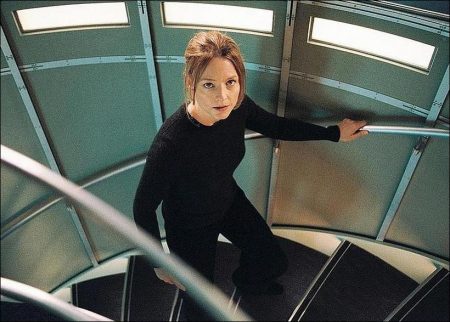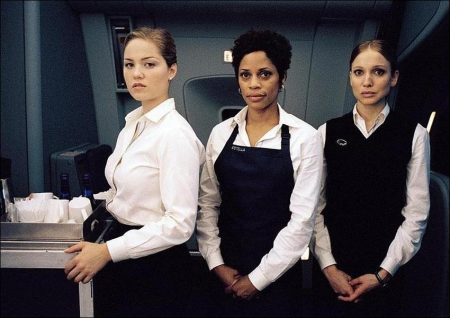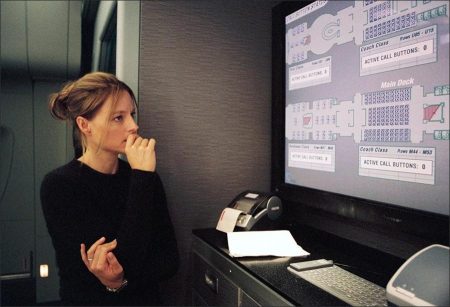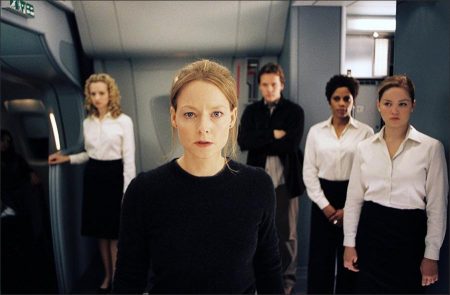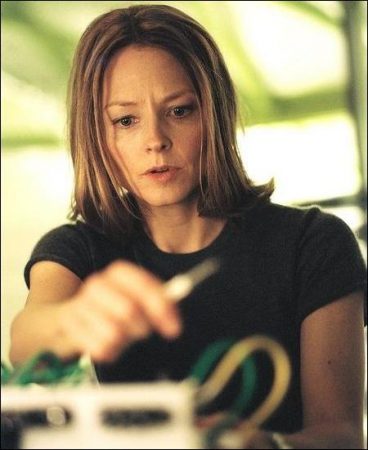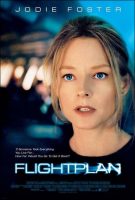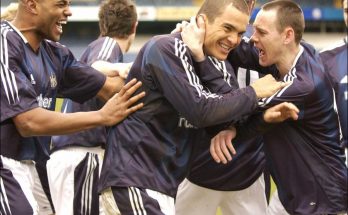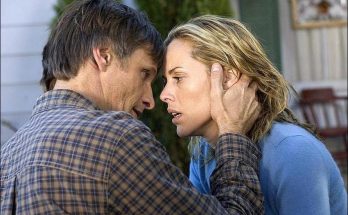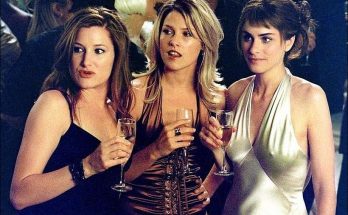The Flight Departs
At a time when an insidious sense of anxiety pervades the very act of flying, FLIGHTPLAN invites audiences aboard a sophisticated suspense thriller that takes place entirely on an airplane – an enclosed realm where, in today’s world, isolation, fright and suspicion are already heightened to the max. When Kyle Pratt’s daughter is nowhere to be found on board, this devoted mother is drawn into a complex web of mystery, treachery and perceived conspiracy that will take her to the very depths of maternal tenacity… and bring the audience along for the ride.
Though the story of FLIGHTPLAN was developed long before the events of September 11, 2001, the screenplay took on an increased relevance in its aftermath – reflecting a new era of international travel filled with uncertainty and palpable awareness of one’s fellow passengers, as well as intensified feelings of protectiveness among parents. The film’s story was never one about terrorism, but in the wake of September 11, its themes of paranoia and shifting perception of strangers came even more to the fore.
It was the script’s mix of human emotions, ethical dilemmas and edge-of-your-seat thrills that garnered the attention of Academy Award-winning producer Brian Grazer. Known for a diverse taste in material that has brought him from the gritty 8 Mile to the award-winning A Beautiful Mind, Grazer felt that this complex, high-intensity thriller would be an intriguing addition to Imagine’s dynamic slate of feature films.
“The feeling of FLIGHTPLAN was that of a Hitchcockian mystery taking place entirely in the sealed world of a modern jet airliner with all its nooks, crannies, shafts and hiding places,” says Grazer. “The combination of this irresistible idea with a very real, emotionally resonant human story about loss and grief was quite powerful.”
Screenwriter Peter A. Dowling had originally been inspired to write the first draft of FLIGHTPLAN by a very simple idea that popped into his head – an idea that seemed to have endless possibilities for generating suspense and mystery. It was a contemporary twist on one of the most compelling mystery themes in cinema: the sudden, inexplicable disappearance of a loved one.
“A parent on a plane at cruising altitude has their child suddenly vanish and nobody admits to ever seeing her onboard. That idea was just the start of things because I realized that from there you could go in so many different directions,” he explains. “It could be a supernatural story. It could be an alien abduction. It could involve hallucinations or fantasy. Or, it could be a very realistic thriller. That was the direction (and the challenge) that really interested me because I’ve always been intrigued by very tightly plotted suspense movies, especially ones that take place in a confined location. At the same time, I thought this could also be a very emotional journey in which a parent faces a harrowing personal crisis.”
“FLIGHTPLAN has a premise that just grabs you,” says executive producer Robert DiNozzi who brought Dowling’s initial script to James Whitaker at Imagine Entertainment. “It’s obviously a very exciting idea but there’s also something very primal there that I thought would resonate with audiences. The thought of your child disappearing and then being thrust into a situation where no one believes you, no one can help, you have no idea who to trust, or if you can even trust own sanity, has a strong emotional pull.”
At Imagine, Brian Grazer was also intrigued by Dowling’s draft but had an immediate idea for adding a whole new layer to it: rather than have a traditional male lead as the script called for, Grazer suggested something completely different. He came up with the notion of casting the Academy Award-winning actress Jodie Foster – with whom Grazer has wanted to work for years – as the strong, yet mysterious, personality at the center of the story’s suspense.
“For a thriller like this, there is no one better than Jodie Foster,” comments Grazer. “She is someone who engenders empathy, who you really care about, someone you can believe as a mother yet who also can demonstrate a tremendous amount of strength and power when she’s put to the test.”
When Foster signed on to the role, the entire production was re-energized. Grazer then brought in screenwriter Billy Ray to further develop the story for Foster, re-creating Kyle Pratt (the name remained the same) as a grieving widow whose maternal drive kicks into its highest gear when her daughter goes missing under circumstances that no one can understand or explain.
Ray found the story rife with potential for rich psychological drama. “When strangers are stuck on a plane together, and you add tension and suspicion into the situation, it becomes a very explosive way to explore how humans react under pressure. You see people’s humanity emerge in both good and bad ways as they make tough choices.”
He continues: “To me, FLIGHTPLAN is very much about dread and it’s all seen through the eyes of Kyle Pratt, of Jodie Foster, as this very smart yet possibly unstable widow who you just don’t know if you can trust or not. I knew that Jodie would bring lots of intelligence to the movie and, as we wrote the story around her character, she kept pushing us and challenging us to make the film smarter and tighter.”
When it came to finding a director for FLIGHTPLAN, Grazer and executive producers Charles J.D. Schlissel and Robert DiNozzi again went in an entirely unexpected direction – turning to Robert Schwentke, a German indie filmmaker acclaimed for his daring and original films Tattoo and The Family Jewels. Grazer and the rest of the team were impressed with the young director’s ability to create a very intimate experience of tension and excitement throughout his films.
Says Charlie Schlissel: “Robert is a brilliant young director who is one of the most visually innovative and meticulous people I have worked with. He sees the world in a different way, has a painstaking eye for detail, and is a lovely human being. He was especially integral in giving the story its emotional anchor.”
Adds Grazer: “Robert directed this very intense, visceral film called Tattoo and watching that film I knew he understood how to scare people, how to create suspense and how to have every moment accelerate into the next. I felt he would also provide a great counterpoint for a thriller that we wanted to break out of the genre.”
Schwentke was drawn to the idea of a thriller set in such an unusual and tightly enclosed space and also welcomed the opportunity of working with such weighty material. “At its heart the story deals with a woman who has to rebuild her psyche after the sudden death of her husband. Exactly how he died is not revealed until late in the movie, but it is clear that she is starting to lose her grip on reality as a result.
The question of whether and to what degree this is happening constitutes the dramatic engine of the movie. This is further compounded by the fact that Jodie’s character has now become the sole caretaker of her 6-year-old daughter. Despite her own grief, she must go on for the sake of the girl.”
Vanished at 37,000 Feet
At the center of the mounting tension and spiraling human intrigue in FLIGHTPLAN lies Kyle Pratt, a widow wracked with grief, and a mother who finds herself in an unimaginable position: trying to make an entire airplane’s crew and passengers believe that her little girl has somehow disappeared from plain sight.
One of her generation’s most accomplished leading actresses, as well as a distinguished director in her own right, Jodie Foster brings tremendous energy and complexity to the role of Kyle, embodying every detail of her transformation from numbed grief to horrified shock to galvanized action as she stops at nothing to solve the gut-wrenching mystery that has taken her daughter.
Foster, who first gained notoriety and an Oscar nomination as a teenager giving a stirring performance in Martin Scorsese’s “Taxi Driver,” has been a distinctive creative force in Hollywood for the last few decades. She has twice won the Academy Award: for her stunning performance as a rape victim in The Accused and for the unforgettable role of FBI Agent Clarice Starling in the now-classic thriller The Silence of the Lambs. Her versatility in recent films has brought her from the edge-of-your-seat suspense of The Panic Room to the lavish period drama of Anna and the King to a French-speaking role in Jean-Pierre Jeunet’s acclaimed war film A Very Long Engagement.
As a mother of two, Foster felt a strong affinity for FLIGHTPLAN from the minute she heard about the story from Brian Grazer. “What really moved me about FLIGHTPLAN was the idea of a woman who has lost her child and yet suddenly is forced to question her sanity because there’s so much grief inside her that she has to wonder if she’s going insane,” says Foster. “Meanwhile, she’s in this strange sort of international world of an airplane where people are naturally suspicious of one another, so the situation has tremendous tension and pressure to it.”
Foster continues: “I also have always liked the idea of stories that unfold inside confined spaces. I like the intensity and how the story always winds up being about how people cope with one another and change inside that space. This movie is a thriller but it’s also a personal journey – a glimpse at how one woman reacts under the greatest sort of stress and panic, how she pulls herself back from the abyss of grief and gets herself together. I think that Kyle isn’t really so much heroic as she is absolutely driven. She might sometimes be brash, sometimes irrational, other times manipulative. But she will do anything she can to find her daughter.”
Another draw for Foster was the chance to collaborate with Robert Schwentke, who, though not well known in the U.S., had impressed Foster with his film Tattoo. “I thought Tattoo was an extraordinary film and was very interested to work with him,” she says. “He’s smart, interesting and had a very, very strong vision for FLIGHTPLAN.”
Schwentke, in turn, found working with Foster to be a constantly exciting and revealing experience. “She is utterly fearless. She is able to take herself or her character to emotionally uncomfortable places. She is totally committed to the role and every one of her choices reflects that. If something is truthful for the character, she will do it even if that makes her appear less likeable or out of control. She has the amazing ability to repeat the same line fifteen times, making every take sound different and as though she is saying it for the first time. I felt very, very lucky.”
In the middle of the flight, as Kyle Pratt’s terror and paranoia snowball, a ray of hope appears when a passenger reveals himself to be an air marshal – a policeman in the sky and a new fixture on flights in the post 9/11 world. Air Marshall Gene Carson must now attempt to figure out if Kyle is simply a distraught mother searching for a lost little girl or a dangerous threat to all the other passengers. To play the role, the filmmakers were pleased to bring on board Peter Sarsgaard, an actor known for his complex and critically acclaimed performances in such films as Kinsey, Garden State and Shattered Glass.
Sarsgaard was impressed with Flightplan’s sophisticated take on suspenseful storytelling. “I thought it was a terrific combination of genres,” he says. “To me, at first, it was a movie about grief, but then it transforms itself into a thriller and a drama and a mystery with lots of twists and turns. It becomes a kind of labyrinth. There’s definitely something very Hitchcock about it.”
Although he was intrigued by the role of Gene Carson, Sarsgaard worried at first that he wasn’t physically intimidating enough to play an air marshal, only to learn that one of the main qualities of an air marshal is the ability to blend into their surroundings and not stand out. He also realized that air marshal’s are being so heavily recruited that they come from all walks of life. After being cast, he met with several real life air marshals to get a better sense of the rapidly burgeoning job.
“What I learned is that an air marshal wants to be very discreet and yet have a sense of overwhelming authority at the same time,” Sarsgaard explains. “It’s quite fascinating work and they tend to take the most interesting flights – high-risk flights on the biggest planes with lots of different kinds of passengers. It’s also a job that requires a lot of patience, because 99.9% of the time, you have nothing to do but sit on the plane and be aware of who people are and what they are doing around you. It’s kind of like an endurance test! But when something does happen, you have to be prepared to react.”
Carson is quickly thrust into an unexpected situation on this flight when a child appears to have gone missing… or alternatively, a passenger seems to have lost her mind, depending on who you are willing to believe. “This movie is very much about first impressions and different perspectives and how you can see a mystery different ways depending on how you look at it,” says Sarsgaard. “I found that really interesting.”
Sarsgaard was also excited to work so closely with Jodie Foster. “She has amazing enthusiasm and passion,” he comments. “It’s wonderful to act with someone who is so engaged and cares so much about every little detail of every scene even though she has already had so much success in her career.”
For Robert Schwentke, Sarsgaard brought a unique approach to the role. “In real life Peter is an avid chess player, and he approached the role with a player’s brain. Ultimately I think we both see Gene as a man who has spent too many hours sitting on a plane with nothing to do but ruminate. Combined with his sense of ego, that proves to be quite combustible.”
Air Marshal Gene Carson does have to answer to one person on board the airliner – Captain Rich, the pilot of the aircraft and the one man ultimately in control of the fate of Kyle and her daughter, whether or not she is truly on the plane. Searching for someone with a commanding and steely presence to add to the film’s tension-charged environment, the filmmakers quickly agreed that Sean Bean, known for playing strong characters in such action epics as The Lord of the Rings, National Treasure and GoldenEye, was perfect for the role.
Says Schwentke: “Sean inherently possesses all the pertinent qualities of Captain Rich. He also brought a tremendous amount of humanity to the character. His captain wants to make the right choice, but is caught in a situation that wasn’t covered in his rulebook.
Bean was taken in by FLIGHTPLAN’s mysteries. “By the time the pilot gets involved, no one is sure if Kyle got on the plane with a child in the first place or whether she might be having delusions or what is going on,” he explains. “My character, being a father himself, tries to empathize with her. He’s not quite sure if he’s a believer or not. He wants to believe her, but he’s also suspicious that she might be some kind of danger to his flight, and safety is his first priority.”
Bean especially took pleasure in the intriguing interplay between his character, Jodie Foster and Peter Sarsgaard, as they try to size one another up and figure out one another’s agendas. He recalls, “It was such a thrill to watch Jodie Foster work because she is so incredibly focused. Meanwhile, Peter Sarsgaard’s performance is very subtle, yet realistic and believable. It was inspiring to be in the middle of that.”
Especially revealing to Bean, as for the rest of the cast, was working inside the replica of a fictional but incredibly detailed state-of-the-art airliner. “It really is a cramped and claustrophobic atmosphere that seems to magnify tension and suspense,” he observes. “Everything is so close and you can’t even walk past someone without bumping into them. It was quite challenging from a filmmaking perspective, but I think it works incredibly well for this story because the audience will really feel like they’re in the sky with us, trapped in this small space, going on this scary ride.”
Turbulance: The Flight Attendants of Flightplan
Kyle Pratt’s terrifying flight grows more complicated as she enlists the help of the plane’s flight attendants to find a child they aren’t even sure really exists. With the formidable talents of Foster, Sarsgaard and Bean already cast, the filmmakers were looking for actors who could hold their own against them, but also wanted the kind of youthful performances more often seen in independent films. So they cast two rising young actresses: Erika Christensen, who stunned audiences with her portrayal of Michael Douglas’ drug-addicted daughter in Traffic, plays the sympathetic Fiona; and Australian newcomer Kate Beahan, who starred in the Down Under indie hit Chopper, is the suspicious Stephanie.
Christensen’s interest was immediately piqued by the role. “I thought FLIGHTPLAN was intriguing from an actress’s standpoint because it’s a story that takes place entirely on a plane. Every character is there in every scene and you have to map out exactly where you are and what you’re doing at every moment,” she explains. “I also thought the screenplay was very timely given today’s concerns and managed to be at once scary and moving.”
Helping Christensen to prepare for the role was her own family history in the aviation world. “My grandmother was a stewardess – back when they were called `stewardesses’ – and both my grandfathers and my mother were all pilots. My family’s aviation stories were always adventurous and glamorous, so that was another reason I wanted to be a part of this film. I think aviators and flight attendants have always had that `ready for anything’ attitude, but today they really have to be on alert and ready for new and dangerous security situations. I think they are real heroes.”
Today’s flight attendants, of course, face far tougher challenges that simply serving tea and coffee to passengers – they also serve as the first line of security in defense of the plane. Christensen was fascinated to learn just what flight attendants go through in preparation for their jobs in this day and age. “Robert Schwentke sent me a six-inch thick manual that today’s flight attendants must know inside and out! I studied the manual and also had training sessions with a professional flight attendant instructor,” recalls Christensen.
Christensen’s character Fiona is still a rookie on only her second international flight. “My character is an individual, although she really wants to be part of the group,” says the actress. “And when she sees Kyle going through such intense emotions, it’s really hard to ignore. She has to do her best to figure out whose side to be on, while also not alienating anyone.”
Masking her native accent, Australian actress Kate Beahan took on the role of the flight’s other attendant, the more senior and more jaded Stephanie. “The script was so much more textured than most thrillers that you see, and I felt that setting a mystery like this on an airplane, especially at this point in time, was a daring thing in itself,” she says. “It really captures that kind of universal fear of being trapped in a devastating situation and nobody will hear your story.”
Like Christensen, Beahan was thrilled to have the opportunity to work with Jodie Foster, who took the actress by surprise. “She was generous, fun and very smart, with absolutely no pretense to her,” says Beahan.“I felt so fortunate to work beside her.”
Also working beside Foster – right up until the minute she vanishes from sight – is seven year-old Marlene Lawston, who makes her feature film debut in FLIGHTPLAN in the key role of Foster’s daughter Julie. The filmmakers searched for a young girl who could make an indelible impression on the audience so that her sudden absence would be palpable and disconcerting.
“Marlene was amazing,” notes executive producer Charlie J.D. Schlissel. “She definitely had a lot to face — this was not only her first movie, but she also had to act opposite Jodie Foster in every scene! It could have been a very intimidating thing, but Marlene was a delight to work with and stepped up to the challenges.”
Foster also found Marlene to be a source of inspiration for her character. “Marlene is only seven, but she has the most piercing, intense presence,” says Foster. “I love working with child actors and watching them change through the course of the film.”
Adds Schwentke: “Jodie, having been a child actress herself, was a tremendous help to Marlene and at some point Marlene started emulating Jodie, which was perfect for the role.”
Fasten Your Seatbelts: A Tour of Aalto Air’s E-474 Jumbo Jet
Central to FLIGHTPLAN’s design from the beginning was bringing the audience directly into the action, letting them feel as if they, too, are trapped on a colossal airplane hurtling at several hundred miles an hour as the mystery of Kyle Pratt and her frenzied search for her daughter unfolds. For the audience, as for the characters, almost the entire movie is spent within the fictional plane known as Aalto Air’s E-474 jumbo jet, the latest in high-tech, multi-level passenger comfort – and a plane just large enough that a child could perhaps be lost inside its crevices.
As conceived by Brian Grazer and Robert Schwentke, the E-474 is a next-generation people carrier with a stunning passenger capacity of 700+ and a stylish, design-forward architectural structure. The plane’s snazzy upper deck includes the cockpit, spacious first class seating, a mod orange- and white-hued first class lounge with a stairway, galleys, and two enormous coach cabins replete with working video monitors installed in the seats. Down below is the sprawling business class section with its signature red seats, two more galleys and more main cabin seating all accentuated by a stunning spiral staircase leading to the upper deck.
Key to creating the film’s suspense was making this singular set palpably realistic. To accomplish the Herculean task of bringing to life the intricate details of a plane that doesn’t actually exist, the filmmakers brought in a team of talented visual artists including production designer Alexander Hammond and director of photography Florian Ballhaus. Schwentke collaborated closely with both men, sharing with them his vision of the film’s visual frisson.
“Being on a long flight is a bit like being underwater. Everything seems muted and out of time,” he observes. “I wanted to capture a dream-like quality.”
Alexander Hammond, who previously created the live action world of Dr. Seuss’ The Cat in the Hat, which Brian Grazer also produced, immersed himself in the principles of modern airliner design. He scoured tens of thousands of images to create dozens of blueprints, often sketching the plans himself. Recalls Hammond, “We looked at a bunch of different aircrafts from many diverse manufacturers and then selected features that seemed both familiar yet had elements that nobody had seen before.”
Eventually Hammond and his team came up with an elevated, 300 foot-long set piece with side panels sculpted out of large blocks of styrofoam to create the walls of the plane. The crew spent 16 weeks building the plane from scratch on a 27,000 square foot soundstage in Los Angeles. Rather than create a multi-level set, the plane was designed so that it could serve as the upper deck for the early days of shooting then be completely reconfigured to become the jumbo jet’s lower deck for later scenes. The plane’s interior was designed with a distinctly hip, retro look to highlight the contemporary emphasis on style in airliners.
Says Hammond: “We looked at a lot of older planes and 60s architecture for ideas. So, there’s a bit of retro design to it with a lounge and a bar – it hearkens back to some of the comforts and fun that have been lost from air travel today.”
A second soundstage housed the sets for the areas of the aircraft that usually remain unseen by airline passengers – yet become absolutely vital in Kyle Pratt’s desperate search for her daughter – including the cargo hold, the flight deck, the crew’s sleeping quarters, an attic containing the majority of the aircraft’s piping, ducting, air ventilation, and wiring systems, the front landing gear, and the electronics room, which is essentially the brain of the plane’s avionics equipment.
“One of the advantages to building a plane from scratch is that the design of every space can be used to enhance specific elements of scenes,” says Robert Schwentke. “A bright white galley might mirror the dislocated and eerie feel of Jodie’s character, or we would lower ceilings for scenes where we wanted to create a feeling of being trapped. Alec was great at approaching the sets from two different angles: the psychological and the functional. By and large the design of the plane was derived from who the characters are, what situations they find themselves in, and where we wanted to locate them and the audience emotionally.
To learn more about how to move through the set in a realistic way, cast and crew also attended a rapid-fire “flight school,” a down-and-dirty introduction to aviation overseen by technical advisor Mark Burton, who introduced them to the basic operation of high-tech aircraft equipment, as well as the basic principals of air safety.
The sets were stunningly real to all who visited them, but when director of photography Florian Ballhaus saw them, he realized a big challenge lay ahead. He would have to develop some ingenious techniques to light and operate the cameras within the plane’s tight spaces. To save space, Ballhaus had Hammond’s crew actually designed lighting right into the set and rigged five foot wide, hinged side panels on the walls of the plane, which could lift open and allow the camera crew to position themselves in a variety of ways. Hammond also designed for Ballhaus a clever set of topside rails running atop the overhead bins which allowed the cinematographer to grab wheeled dolly shots from above.
With no Aalto plane actually in existence, the filmmakers also had to find a way to show the E-474, with its unique silhouette, flying from the outside. They turned to the visual effects team of Rob Hodgson and Henric Nieminen, who forged a 30-foot long working model of Hammond’s design that could be used for the handful of external shots.
Back on the set, the filmmakers further added to the realism by bringing in a group of carefully cast extras to play the flight’s passengers. Explains Brian Grazer: “We wanted to create a population similar to what you really experience on an international flight, so you have the wise guy, the loud family, a whole potpourri of diverse individuals from every ethnic background. Some are intrusive, some are suspicious and some are supportive to Kyle which makes it all very interesting and realistic.”
The uncannily flight-like atmosphere on the set gave the cast and crew a real sense of working in such a cramped and claustrophobic space. So it was some relief that the production enjoyed a respite from the airplane set by spending several days filming on location in the city of Long Beach and at a small airport in the Mojave Desert which, ironically, doubled as the frozen airport of Goose Bay, Newfoundland.
The film’s only other earthbound location is the cosmopolitan city of Berlin, where the production journeyed for two weeks. Although the decision to shoot in Berlin was made before Robert Schwentke and Florian Ballhaus joined the production, the two German natives were thrilled to have a chance to capture the city’s unique atmosphere and stunning mixture of contemporary and classical architecture. They also filmed for three days outside Berlin in the city of Leipzig, where cast and crew were given unprecedented access to the newly built glass and steel airport there.
Says Schwentke: “In many ways the shooting locations were reflections of inner states; this holds especially true for Berlin. We wanted a nocturnal, deserted city that felt slightly surreal and disconnected. Having spent winters in Berlin I knew we could create that feeling for the beginning of the movie there.”
Atmosphere and ambience were always the central elements in Schwentke’s vision for turning FLIGHTPLAN into a riveting suspense thriller. He says: “The thing I love to do as a filmmaker is to completely create a world with its own rules, sounds, colors, and textures, while still engaging the audience on an emotional level. I hope they will be scared, intrigued, and touched.”
Flightplan (2005)
Directed by: Robert Schwentke
Starring: Jodie Foster, Peter Sarsgaard, Erika Christensen, Sean Bean, Marlene Lawston, Haley Ramm, Jana Kolesarova, Kate Beahan, Mary Gallagher, Judith Scott
Screenplay by: Peter A. Dowling, Terry Hayes, Billy Ray
Production Design by: Alec Hammond
Cinematography by: Florian Ballhaus
Film Editing by: Thom Noble
Costume Design by: Susan Lyall
Set Decoration by: Simon-Julien Boucherie, Kathy Lucas
Art Direction by: Kevin Ishioka
Music by: James Horner
MPAA Rating: PG-13 for violence and some intense plot material.
Distributed by: Buena Vista Pictures
Release Date: September 23, 2005
Visits: 112
